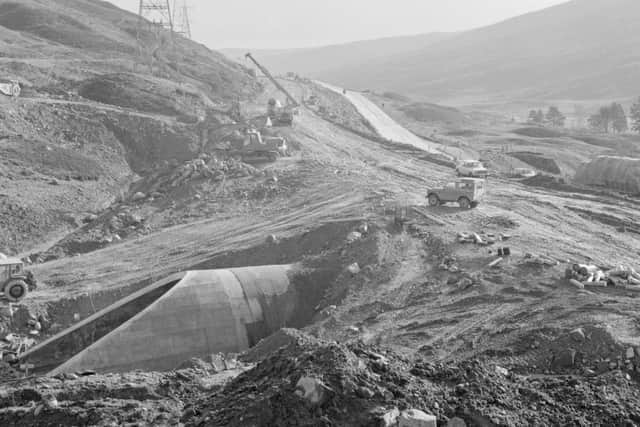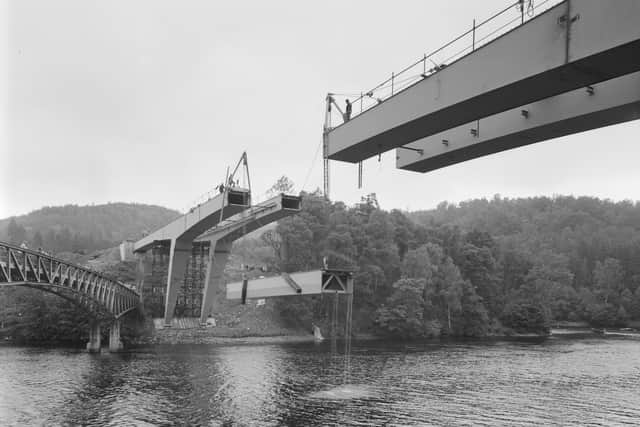Huge A9 upgrade 50 years ago was completed faster than dualling scheme
It was a complete rebuild of the A9 between Perth and Inverness that was achieved half a century ago more rapidly than it is taking the Scottish Government to finish the dualled sections.
After ministers admitted it will take them an extra ten years to get the job done, roads engineers who worked on the previous, epic scheme have told The Scotsman of how it transformed travel on the “Highland Highway”, and the author of a forthcoming booklet on the project described it as an “incredible feat”.
Advertisement
Hide AdAdvertisement
Hide AdWhile much of the A9 remains single carriageway, the upgrade which started in the 1970s significantly sped up traffic by removing bottlenecks, bypassing every town and village on the route, replacing narrow bridges and even diverting a 200m section of the River Tay.


Keeping the road open in the winter is also now much easier because it is wider and straighter.
Bridge technician Duncan Macknight will chronicle Scotland’s biggest 20th century road scheme in a booklet due to be published by next summer for the Scottish Roads Archive. It was built between 1972 and 1986, while ministers have admitted their 2011 pledge to complete dualling by 2025 will not be met and will take until 2035.
The previous scheme was completed with a dual carriageway viaduct on stilts through Killiecrankie. However, traffic levels did not justify full dualling of the route, with a series of long, sweeping single carriageway curves being designed instead to permit overtaking.
Mr Macknight, who works for road maintenance firm BEAR Scotland, which covers the A9, said: “The project allowed the Highlands and Tayside to become what they are today. The upgrade of the old A9 was an incredible feat of engineering design and construction, with 120 miles of brand-new road completed within 14 years, all to a very high standard.


"Having spoken to a great number of the folk involved, building it was certainly a challenge. The stretch over Drumochter pass was hampered in the winter by freezing temperatures and heavy snowfall. Work was at times halted over Christmas due to the conditions.
"Substantial quantities of rock and deep peat bogs all caused issues, as were the 12 major river crossings, involving the construction of large bridges."
The scheme, over a route that has existed for more than 500 years, built on General Wade’s military road between Dunkeld and Inverness in 1725, improvements a century later by Thomas Telford and a further upgrade in the 1920s, when the A9 was given its name.
Advertisement
Hide AdAdvertisement
Hide Ad

Robin Brown, 72, who worked on the Dunkeld section as a graduate engineer for civil engineers Babtie, Shaw and Morton from 1972, said the project was revolutionary. He said: "There was a sense of pride – it was a national project.
"Some of the narrow bridges that were replaced were single lane, so vehicles had to give way to each other as there were no traffic lights.
"I used to go skiing and the challenge was to get to the Winking Owl [bar] in Aviemore before it closed at 10pm after work on a Friday, which was a four-and-a-half hour journey from Glasgow. Once the road was improved, you could get there in fewer than three hours.”
However, Mr Brown also acknowledged: “The lack of straight stretches meant the road blended in with the landscape by following the contours and shape of the hills, but it restricted the number of overtaking opportunities.


"Originally, I think the A9 should have been dualled from Perth to Pitlochry and not beyond, because that’s where the main traffic flows are, along with at a few pressure relief points. I think that would have been a better solution."
Mr Brown recalled a very different working environment, with labourers wearing Wellingtons rather than steel-capped boots, plans being worked on at drawing boards rather than computers, with copies made using tracing paper and being sent to work sites by post.
He said: "We were using slide rules predominantly. One of my colleagues was given a calculator, which cost £78 [the equivalent of some £700 today]. It was the envy of everybody. These sort of calculators you can now buy for £3.”
Ronnie Land, 81, a project engineer with Babtie, Shaw and Morton who worked on the Dunkeld, Luncarty and Birnam sections, said the Dunkeld stretch was the trickiest to complete because it goes through a narrow pass – and dualling would be equally difficult .
Advertisement
Hide AdAdvertisement
Hide AdHe said: "We had to divert the Tay. If you interfere with nature at any scale, if you don’t keep the energy of the river the same when you finish the diversion as when you start, you get scouring and deposition, and it finds a different path and you get all sorts of trouble.
"The fishing was destroyed for two or three years. A lot of money was handed over."


Mr Land said the Dunkeld section was built by combining elements of some of the 26 options, which he revealed resulted in a “snaky” part north of a new bridge over the river.
He predicted dualling the stretch would be challenging, with designs to be exhibited at the end of January.
Mr Land said: "When we had finished designing the Dunkeld bypass, the client [the Scottish Office] said they had assumed we had thought about where possible dualling could take place, to which the truthful answer was no.
"Dunkeld was really difficult to get a road on, so we quickly realised what you couldn’t do was just build another carriageway alongside it – that cannot be done and won’t be done in the future.
"It’s going to have to be built partly on one side of the existing road and partly on the other, and that’s going to be really messy."
Comments
Want to join the conversation? Please or to comment on this article.